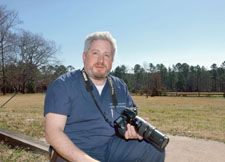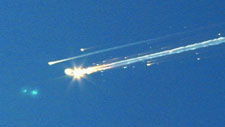What started as a casual backyard outing for a Tyler, Texas cardiologist/amateur photographer/self-professed "space enthusiast" turned into "80 of the most unforgettable seconds" of his life as he captured the space shuttle Columbia falling apart. Dr. Scott Lieberman is a man accustomed to thinking very fast. In his line of work, it's a necessity, and so is preparation. In a cell phone interview conducted while he scrubbed for an angioplasty operation he was about to perform, Lieberman recalled to Poynter Online that he "was thinking artistically" Saturday as he readied his Canon EOS-D60 (6 mega-pixel PROSUMER camera), mounted with a 75-300mm image stabilizing lens fitted with a polarizing filter. Lieberman gave his wife Robyn a Canon Alura 40, and his 9-year-old son Mason the Canon binoculars to watch the shuttle pass over head. "It looked normal," Lieberman told the Tyler Courier-Times-Telegraph. "Then I saw the fragments, and that's when I started getting a little worried." Lieberman knew that he had to share what he had recorded. With the help of Jim Giametta, Executive Editor at the Tyler Courier-Times-Telegraph, and the Associated Press, Lieberman's eight digital files were shared with the world.
Newspapers, magazines, TV stations and websites around the world were using his pictures only a few hours after he captured the Columbia tragedy in the big sky over Texas. Giametta, a 30-year veteran at the Bothwell & Clyde Family publication recalled, "We are the 10th largest newspaper in the state of Texas, and this was big news for us. He wanted to share the picture and I assisted." "He had (counting) 1, 2, 3, 4 … 8 frames, and we agreed that for the sake of accuracy that we were not going to blow the images up more than they could stand. We wanted to be very clear about [not] changing history." "You can take this to the bank, in my years in the business, this is one of the -- if not the -- biggest things that I have ever covered. There was no enhancement at all," said Giametta. Robert (Bob) Daugherty, Director of the Associated Press State Photo Center in Washington, negotiated and received the image from Lieberman. He says, "There is no doubt in my mind that the image is accurate, and I have never seen a single image (in his 40-year AP career) get such universal front page play. It is the digital image that played around the world."
Vin Alabiso, Vice President/Executive Photo Editor
for Associated Press worldwide, thanks Lieberman and the staff at Tyler
Courier-Times-Telegraph saying, "We (the media) owe a tremendous
debt of gratitude to Dr. Lieberman and the Tyler staff." This picture is unusual on two levels, within the corridors of newsrooms around the world. First, according to Alabiso, "There is no question that this photo will be one famous photograph of the year. Additionally, given the technology of the day and our instant delivery abilities, pictures can now move further, faster than ever before. Tyler helped us make this happen." Secondly, while there were many quality video grabs used around the world on Saturday extras, this was a high quality still image. Alabiso adds that, "There is the reality of what we have all been saying for some time now, the still image stands as the icon of time." It is the digital image that played around the world.Michele Stephenson, Director of Photography at TIME magazine, one of the many publications to use Lieberman's picture on its cover, says "We were thrilled to have a real picture (not a video grab) to report this amazing event. I had not seen a picture like that. It is one of the key images of the year and will go down in history as a lasting picture that is simple, elegant, clear and direct." Lieberman has been contacted by "Inside Edition," "Good Morning America," and many others. He is also being asked about the starburst in one of the first images he captured. Lieberman responds, "There are those more qualified to answer the question of what caused the star effect. Maybe it's the ionization on the bright object, but I think it is lens flare from the bright light." And to the people who think that the image could
be the picture of the year, Leiberman says, "It's February 1st."
And life has a way of changing before our eyes. © Kenny F. Irby |
|
|
Write a Letter
to the Editor |


